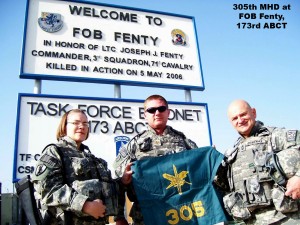Written By: Patrick Feng
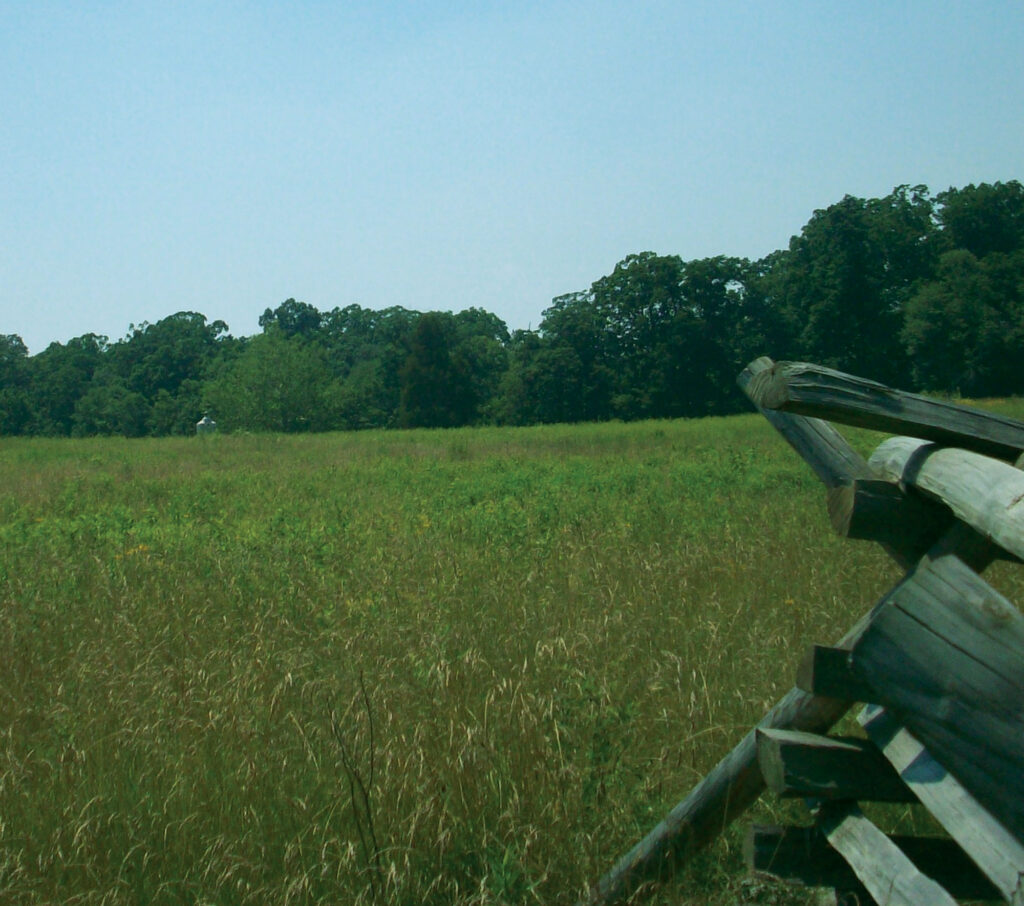
After a series of Union setbacks in the summer of 1861, it became clear that subduing the Confederacy would not be achieved by way of a single decisive battle. In response, President Abraham Lincoln called for an additional 300,000 volunteers to serve a period of three years. As the war progressed into 1862, Lincoln called for an additional 300,000 men to serve for nine months. The 27th Connecticut Volunteer Infantry was one of several regiments raised as a result of Lincoln’s proclamation in the summer of 1862.
The recruits that formed the 27th Connecticut hailed mainly from the city of New Haven and the surrounding towns, including Wallingford, Meriden, Branford, Clinton, and Guilford. The regiment was largely comprised of married, middle-aged men, with the average age being twenty-seven years old. Among the recruits was an 18-year-old Chinese immigrant named Antonio Dardelle of Clinton, one of the few soldiers of Chinese descent to serve in either Civil War army. (Dardelle survived the war and began receiving a pension in 1912 at the age of 68.)
The regiment was organized and mustered in at Camp Terry in New Haven between August and late September 1862. Since the 27th was technically a militia regiment, the men were entitled to elect their officers. The regiment selected Richard Stone Bostwick as colonel and the regiment’s commanding officer, Henry C. Merwin as the lieutenant colonel, and Theodore Byxbee as major. These were ideal choices, considering they had served with the initial three-month service call at the outset of the war. After several weeks of organizing and training, the regiment set out for Washington on 22 October 1862 with an initial strength of 829 officers and men.
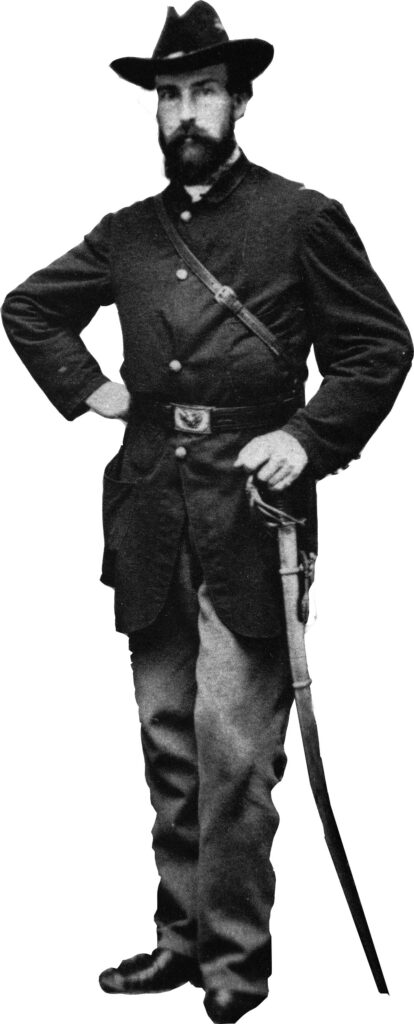
The 27th reached Camp Seward, Virginia, outside of Arlington on 25 October and were posted to garrison duty in the defenses of Washington. However, they were soon reassigned to Brigadier General Samuel Zook’s 3d Brigade of Major General Winfield S. Hancock’s 1st Division in Major General Darius Couch’s II Corps, Army of the Potomac, in preparation for the Fredericksburg campaign.
At 1200 on 9 December 1862, the 27th arrived in camp in Falmouth. The regiment spent the next day cleaning its arms for inspection by Brigadier General Zook and his staff and preparing rations for the inevitable action that was to follow. On the afternoon of 10 December, 250 men from the 27th were detached for picket duty along the Rappahannock River while the Army of the Potomac awaited the arrival of supplies and pontoon bridges.
At 1630 hours on 11 December, Colonel Bostwick gave orders for the preparation of three days’ rations and orders to fall in by 1830. Meanwhile, along the riverfront, the engineers constructing the pontoon bridges over the Rappahannock were subjected to a hail of lead from rebel sharpshooters across the river in Fredericksburg. In response, Union artillery on Stafford Heights opened fire and bombarded the town in an effort to drive off the snipers.
Once the regiment assembled, they joined the rest of the 3d Brigade and marched to where the rest of the corps was waiting at the Phillips House until a crossing could be arranged. Early on the morning of 12 December, the 27th crossed the bridge into Fredericksburg. Company B was detached to help finish laying pontoons a little below Fredericksburg where Hazel Run and the Rappahannock intersected.
After breakfast on the morning of 13 October, the regiment and the rest of the brigade fell into line of battle with the rest of Hancock’s 1st Division on Caroline Street, which ran parallel with the river. There, the 27th waited for orders to storm the heights behind Fredericksburg. When the orders came to move forward, Major General Hancock rode up with his hand raised and addressed the regiment: “You are the only Connecticut regiment in my division. Bring no dishonor upon the State you represent.” Then the division moved forward.
As the 27th Connecticut advanced, it was met with rebel artillery fire from Marye’s Heights, which blew holes in the regiment’s lines. The division then moved forward at the double with bayonets fixed, passing Major General William H. French’s division, which was forced to fall back. As they moved closer to the Confederate positions, the volume of fire from shot, shell, canister, and musketry increased, causing regiments to become intermingled with each other. The 27th managed to advance to a brick house where it and the rest of the brigade were ordered to reform and charge again. In the confusion, the regiment became fragmented and intermingled among the rest of the brigade.
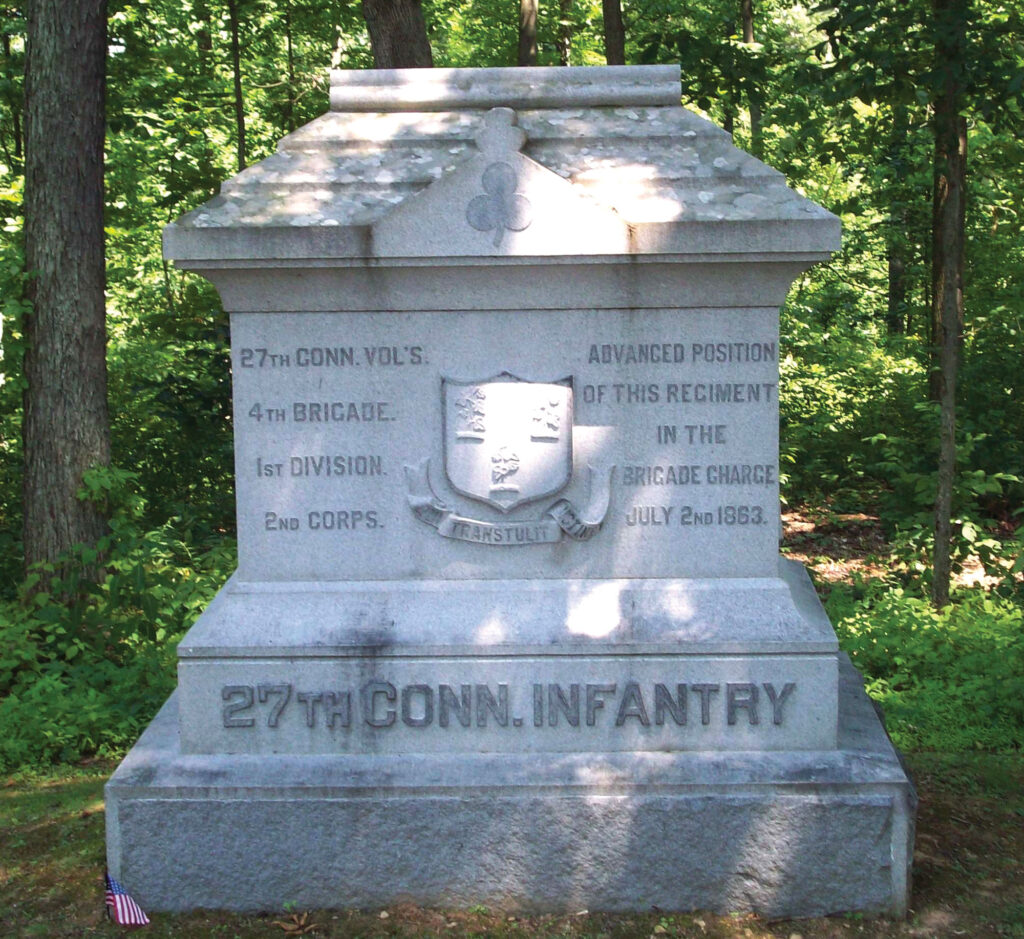
The men of the 27th managed to close within 100 yards of the stone wall at the base of Marye’s Heights, but the continuous musket fire forced them to lie down. There, the men continued to load and fire their muskets when it was possible, and they remained until dusk, when they finally withdrew with the rest of the division back into the town. The next day, the casualty reports of the 27th numbered roughly one-third of the 375 men that were involved in the charge. On 14-15 December, Union forces waited in the town for further orders. After dusk, Major General Ambrose Burnside, commander of the Army of the Potomac, finally ordered his troops to evacuate Fredericksburg and return to Falmouth for winter quarters.

The army reached their original positions on the morning of 16 December under the cover of a heavy rainstorm. On that same day, the 250 men that were detached from the 27th for picket duty along the river rejoined the regiment. They then set to work building log huts for the duration of their stay. The regiment sat wet and demoralized along with the rest of the Army of the Potomac. In the immediate weeks after the Battle of Fredericksburg, Burnside planned another operation that involved sending Major General Edwin V. Sumner’s Grand Division across the Rappahannock at the same point as in the December operation to take the batteries on Marye’s Heights. The other two Grand Divisions under Major General Joseph “Fighting Joe” Hooker and Major General William B. Franklin would cross the river north of Falmouth to turn Lee’s left flank. However, heavy rains fell and delayed the plans indefinitely.
The Confederates on the other side of the river mockingly chanted, “Burnside stuck in the mud!” With the change in seasons came a change in command in the Army of the Potomac, with Major General Hooker assuming command. When spring 1863 arrived, the 27th had been on picket duty along the Rappahannock since the retreat from Fredericksburg in December. The return of good weather brought new plans for another campaign. In late April, the regiment struck camp and made its way to the United States Ford with the rest of II Corps.
The Army of the Potomac crossed with little resistance and made camp near the Chancellor mansion at Chancellorsville. On 1 May, the army spent most of its time fortifying its position. However, the right flank, where the XI Corps under Major General Oliver O. Howard was positioned, was left unsecured. On 2 May at approximately 1600, the Confederate II Corps under the command of Lieutenant General Thomas J. “Stonewall” Jackson advanced in force down the Plank Road, throwing the entire Union right into a rout.
A portion of the Union II Corps arrived on the scene to find Federal forces in a state of panic and attempted to steady the line. The 27th Connecticut was ordered to hold its position. On 3 May, heavy fighting resumed, and the 27th, with the exception of its D and F companies, was ordered to the forward breastworks, which were thrown together on 1 May. As the regiment advanced, it was met with heavy fire from the Confederates as it entered the entrenchments.
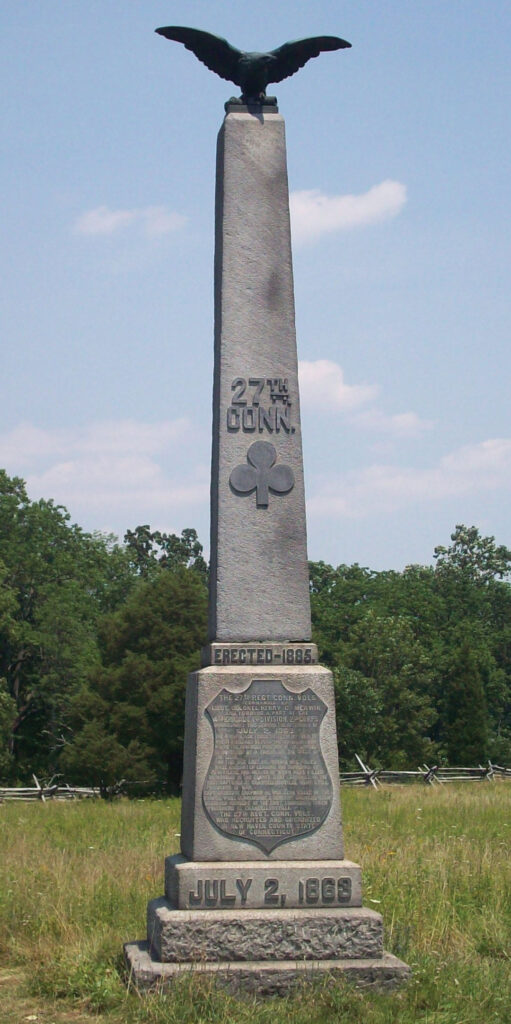
Several other regiments were low on ammunition and began to fall back. The 27th held off repeated assaults and Colonel Bostwick sent for more reinforcements from Hancock. However, the regiment was eventually surrounded. Apparently, Hancock had sent orders for the regiment to withdraw to a new line, but the message failed to reach the 27th in time. Bostwick had no choice but to surrender.
The captured soldiers of the 27th Connecticut were transported to Richmond and held in detention for about a week before being paroled and sent back north to Annapolis, Maryland, where they remained in a convalescent camp. The remnants of the 27th, which included Companies D and F and a handful of other soldiers, retreated with the rest of the Army of the Potomac back across the Rappahannock. After a portion of the commissioned officers were exchanged, Colonel Bostwick returned to command, but he was soon incapacitated by illness. Lieutenant Colonel Merwin replaced Bostwick as the regiment’s commanding officer. After the Battle of Chancellorsville, the 27th had 160 men, comprised of three companies, the third having been formed from the remnants of other companies.
In late June, the Army of Northern Virginia, under General Robert E. Lee, advanced into Maryland, initiating the second invasion of the North. Hooker pursued, keeping his army between Lee’s forces and the Union capital and Baltimore. Hooker was soon replaced by Major General George G. Meade. When Confederate intentions were more clearly understood, Meade decided to concentrate his forces in Gettysburg, Pennsylvania.
As the first day of the battle on 1 July came to a close, the 27th Connecticut, along with the rest of the II Corps, arrived a few miles from Gettysburg and began to entrench on Cemetery Ridge. On 2 July, as Confederate forces under Lieutenant General James Longstreet attacked Major General Daniel Sickles’ III Corps in the Peach Orchard and the Wheatfield forward of Cemetery Ridge, the 27th, along with the rest of the 1st Division from Hancock’s II Corps, as well as elements from V Corps, arrived to reinforce the wavering line.
As the regiment advanced through the Wheatfield, Lieutenant Colonel Merwin was killed. The 27th pressed onward under the command of Major James H. Coburn, pushing the Confederates out of the Wheatfield. However, the Confederates counterattacked, and the division was ordered to retire back to Cemetery Ridge. On 2 July, the 27th Connecticut went into the battle with seventy-five men and suffered thirty-eight casualties, including the regimental commander, killed-in-action. On 3 July, the 27th maintained its position on Cemetery Ridge and watched as Union artillery and musketry shattered the Confederates’ final assault.
The next day, Lee began his retreat back to Virginia, with Union forces making a half-hearted pursuit. The 27th ended its final days of service with the Army of the Potomac in Camp Pleasant near Harpers Ferry on 18 July. They soon traveled back to New Haven, where they received a hero’s welcome. On 27 July 1863, the 27th Connecticut Volunteer Infantry was officially mustered out of the Union Army. Many of the men reenlisted in other regiments and went on to see more combat. In its nine months of service, the 27th had seen action in three of the war’s major battles and had sustained sixty-four percent casualties, including its second commander, Lieutenant Colonel Henry Merwin. The men of Connecticut had indeed endured their trial by fire and survived.


